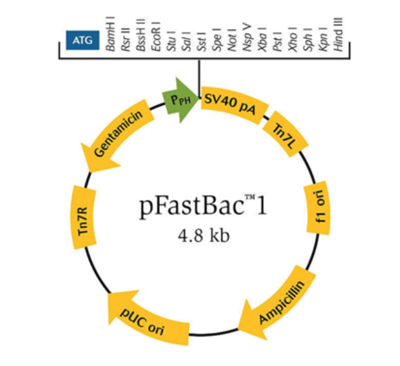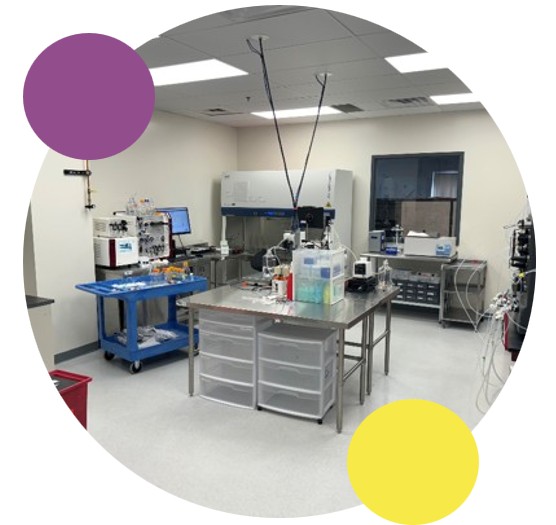Baculovirus Expression Vector System (BEVS)
Curia’s Hopkinton facility is home to a team of scientists who have worked on baculovirus programs for more than 25 years, including the site head who was a member of original team at Pfizer to design BIIC technology (patent application number 20040197914). With dedicated, stand-alone laboratories including upstream and downstream activities, Curia has expressed and purified hundreds of proteins using this system for customers around the world.
 The Baculovirus Expression Vector System (BEVS) is an established method within the scientific and industrial communities for generating large quantities of recombinant protein. BEVS is a eukaryotic system that utilizes the Autographa californica nuclear polyhedrosis virus (AcNPV) for high-level expression of recombinant proteins in Lepodoptera-derived insect cell lines, such as Sf9, Sf21, and High Five cells. Recombinant proteins produced using the system typically have correct folding, disulfide bond formation, and oligomerization, resulting in the production of proteins that are functionally similar to their native forms. The system can accommodate large DNA inserts, perform intron/exon splicing, and yield relatively high levels of recombinant protein (0.1 to 50% of total protein). Short affinity tags, such as polyhistidine, Flag, and Twin-Strep, are often fused to recombinant proteins to aid in detection and purification of proteins. After affinity capture, tags can be removed using recombinant proteases such as TEV, HRV3C, thrombin, or SUMOStar.
The Baculovirus Expression Vector System (BEVS) is an established method within the scientific and industrial communities for generating large quantities of recombinant protein. BEVS is a eukaryotic system that utilizes the Autographa californica nuclear polyhedrosis virus (AcNPV) for high-level expression of recombinant proteins in Lepodoptera-derived insect cell lines, such as Sf9, Sf21, and High Five cells. Recombinant proteins produced using the system typically have correct folding, disulfide bond formation, and oligomerization, resulting in the production of proteins that are functionally similar to their native forms. The system can accommodate large DNA inserts, perform intron/exon splicing, and yield relatively high levels of recombinant protein (0.1 to 50% of total protein). Short affinity tags, such as polyhistidine, Flag, and Twin-Strep, are often fused to recombinant proteins to aid in detection and purification of proteins. After affinity capture, tags can be removed using recombinant proteases such as TEV, HRV3C, thrombin, or SUMOStar.
Key Features of Curia’s Baculovirus Platform
Suspension-based culture for virus production
- High titer virus production within 2 weeks starting from plasmid
- Rapid titer determination utilizing flow cytometry
- Upstream optimization for viral vector production
- DOE studies
- Optimization of culture parameters (e.g. cell density, MOI, virus ratios, incubation time, medium optimization)
- Cryopreserved BIIC cell banks for long term storage of baculovirus
Available platforms include Bac-2-the-Future.
Baculovirus Infected Insect Cell (BIIC)
Baculovirus Infected Insect Cell (BIIC) is a method for preserving and scaling up baculovirus that provides a form of viral stock more stable than the traditional, extracellular stock. This powerful technology:
- Eliminates the need for virus amplification and re-titering
- Drastically reduces the turn-around time and resources required for scale-up
- Improves yield and consistency in protein expression.
Curia offers BIIC through one of the technology’s original co-inventors.
Infection Kinetics Monitoring (IKM)
Curia’s Infection Kinetics Monitoring (IKM) technology was developed by our team of scientists to deliver unmatched reproducibility and scalability for baculovirus mediated expressions and this system is compatible with all popular kit systems that exist in the protein expression marketplace. IKM is a multi-component system that compiles a suite of real time cell population measurements, read during the course of a viral infection. In tandem with standard scouting measures, such as western blot, IKM substantially decreases the guesswork associated with baculovirus mediated scale-up resulting in unmatched scalability and reproducibility. This system also obviates the need for the laborious baculoviral titration saving our client’s time while making expression more predictable.
Baculovirus Particles (BVP)
In addition, baculovirus particles (BVPs) are used to measure polyspecific binding of antibodies in an ELISA-based format for assessing therapeutic antibody developability. Curia’s BVPs have been widely used and cited in numerous scientific publications.
